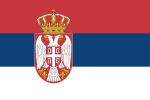Saint Sava
Saint Archbishop Sava Свети Сава | |
|---|---|
 Fresco of Saint Archbishop Sava from the Mileševa monastery | |
| Archbishop of the Serbs | |
| Born | ca. 1175 |
| Died | January 14, 1235 Tarnovgrad, Bulgaria |
| Venerated in | Eastern Orthodox Church |
| Major shrine | Temple of Saint Sava (Belgrade) |
| Feast | 14 January (Gregorian calendar), 27 January (Julian calendar) |
| Patronage | Serbia and Serbs |
Saint Archbishop Sava (or Saint Sabbas; [Свети Сава, Sveti Sava] Error: {{Lang-xx}}: text has italic markup (help)) (cca 1175, Ras - January 14, 1235, Trnovo, Bulgaria), baptised name Rastko Nemanjić (Serbian: Растко Немањић) was the youngest son of Serbian ruler Stefan Nemanja, Eastern Orthodox monk, first archbishop of Serbian Orthodox Church, diplomat, writer, law giver and foundator of several important medieval monasteries.
He is consider one of the most important figures of Serbian history and he is canonized and venerated by Serbian Orthodox Church.
Biography
Early life
Rastko was born ca. 1175 in Gradina (near modern-day Podgorica, Montenegro).
According to his hagiography, in his youth (c. 1192) he fled from his home to join the orthodox monastic colony on Mount Athos (Holy Mountain on the Chalkidiki peninsula) and was given the name Sava. He first traveled to a Russian monastery and then moved to the Greek Monastery of Vatopedi. At the end of 1197 his father, who on becoming a monk was named Simeon joined him. In 1198 they together moved to and restored the abandoned monastery Hilandar (Chilandari, in French) which, since that moment, became the center of Serbian Christian monastic life. Hilandar is one of the twenty monasteries on Mount Athos that still function, and its position in the hierarchy is fourth.
St. Sava's father took the monastic vows under the name Simeon and died in Hilandar on February 13 1199. He is also canonised, as Saint Simeon.
On Mount Athos
Foundation of Chilandar
In Serbia (1207-1217)
Mission in Nicea
Relation with king Radoslav and first pilgrimage
Second pilgrimage and death
Serbian Orthodox Church
After his father's death, Sava devoted himself to the ascetic life and retreated to a skete close to Karyes which he built himself in 1199. He also wrote the Karyes Typicon valid for both for Hilandar and his skete. The typicon has been inscribed onto a marble board at the skete and still stands there. Sava stayed on Athos until the end of 1207.
In 1208, Sava returned to Serbia, where the feuding between his brothers had created a state of anarchy. Sava set up his base at Studenica monastery, and started to organize the Serbian Orthodox Church. He had brought with him several monks to help him perform his pastoral and missionary duty among the people. Sava eventually managed to free the Serbian church from the jurisdiction of the Archbishopric of Ohrid. In 1219, Sava was consecrated the first archbishop of the new Serbian Church by Patriarch Manuel I of Constantinople, who was then in exile at Nicaea.
Saint Sava is considered the founder of the independent Serbian Orthodox Church and Serbian Orthodox Christians celebrate him as patron saint of education and medicine. His legislature (Nomocanon of St. Sava) made him the fist Serbian legislator, being also important for the history of legal education in Serbia. He is commemorated on January 27 according to the Gregorian calendar and on January 14 according to the Julian calendar. Since the 1830s, Saint Sava has become the patron saint of Serbian schools and schoolchildren. On his day, students partake in recitals in church.[citation needed]

Sava died in Turnovo, capital of the Second Bulgarian Empire, during the reign of Ivan Asen II of Bulgaria. According to his Life, he fell ill following the Divine Liturgy at the Feast of the Epiphany on January 12, 1235. Sava visited Turnovo on his way back from the Holy Land, where he had founded a hospice for Syrian pilgrims in Jerusalem and arranged for Serbian monks to be welcome in the established monasteries there. He died of pneumonia in the night between Saturday and Sunday, January 14, 1235. [1] He was initially buried at the St Forty Martyrs Church in Turnovo, but his holy relics remained there until only May 6, 1237 when they were relocated to the Mileševa monastery in southern Serbia. 360 years later, in 1595, the Ottoman Turks unearthed his remains and took them to Vračar hill in Belgrade where they were incinerated on a stake.
The Temple of Saint Sava in Belgrade, at the Vračar plateau, is today the biggest Orthodox church building in the world. Its construction began in the 1930s but was terminated by the Second World War. The construction was continued in 1985 and was completed by 2004. It was built on the place where the relics of Saint Sava were burned by Sinan Pasha, in 16th century. In reality, what is Vračar hill now used to be outside the city walls and not within easy reach. There used to be a different Vračar hill where today is located the Tašmajdan. This place was used by Ottoman Turks for executions and seems much more likely to have been the spot where Sava's relics were burnt. Also, tradition holds the place of burning as "Čupina Umka", the tallest point in Tašmajdan.[2]
Achievements
Church leader
Ktitor
Law-giver
Writer
Saint Sava in tradition and arts
Cult of Saint Sava
Saint Sava in literature
Saint Sava in arts
Saint Sava in popular tradition
Gallery
-
Saint Sava, Archbishop of the Serbs painting
-
Icon of Saint Sava
See also
- Hilandar Research Library (Resource Center for Medieval Slavic Studies, University of Ohio (Columbus))
- Temple of Saint Sava in Belgrade
Notes
External links
- Online Library Cataloging System of Saint Sava
- Sveti Sava Society
- Collected works (Serbian)
- Istorijska biblioteka: Saint Sava
- Attwater, Donald and Catherine Rachel John. The Penguin Dictionary of Saints. 3rd edition. New York: Penguin Books, 1993. ISBN 0-140-51312-4.






